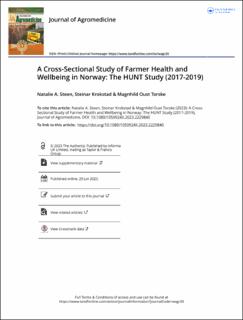| dc.description.abstract | Objectives: Obtain a broad impression of the health and wellbeing of working farmers in a representative population.
Methods: A cross-sectional study using data from a large, general population-based survey, The HUNT Study, Norway (HUNT survey 4, 2017–2019, response rate 54%). The study included 24,313 occupationally active participants aged 19 to 76 years, including 1,188 farmers. Prevalences are estimated for outcomes covering musculoskeletal, respiratory, and mental health as well as general health and life satisfaction, with adjustment for worker age and sex. The estimates for farmers are compared to skilled white collar workers and skilled manual workers.
Results: Farmers had a higher estimated prevalence of poor overall health (prevalence ratio [PR] 1.56 [95%CI 1.34,1.82]), chronically impaired mobility (PR 1.83 [1.53, 2.20]), long-standing musculoskeletal pain or stiffness (PR 1.29 [1.21, 1.37]), work-related respiratory attack (PR 4.32 [3.67, 5.08]), depression symptoms (PR 1.30 [1.04, 1.61]) and symptoms of psychological distress (PR 1.23 [1.04, 1.47]) than skilled white collar workers. The estimated prevalence of poor overall health (PR 1.19 [1.00, 1.41]) and work-related respiratory attacks (PR 1.44 [1.24, 1.67]) was also higher for farmers than skilled manual workers, after adjustment for age and sex. Farmers had greater odds of rating themselves less satisfied with life in general than skilled white collar workers (adjusted OR 1.17 [1.04, 1.31]).
Conclusions: These results are consistent with previous research and add evidence that farm work is associated with high prevalences of a broad range of adverse health outcomes. The associations with chronically impaired mobility, long-standing musculoskeletal pain, and poor self-rated health were strong. The adjusted PRs for work-related respiratory attacks relative to both comparison groups were particularly high. More research is needed to identify and evaluate interventions that can improve farmer health. | en_US |

